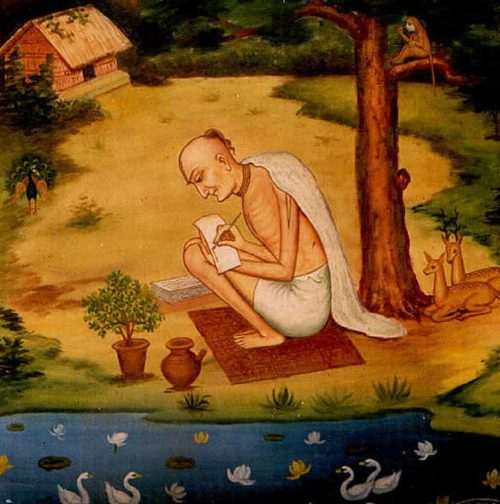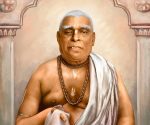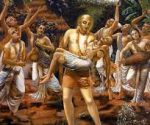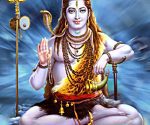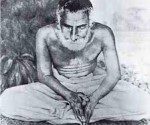Krishnadasa Kaviraja Goswami Appearance
by Prabhupada Rays
Krishnadasa Kaviraja Goswami is the author of Govinda Lila Amrita and the Chaitanya Charitamrita, but he has given very little information in these books about himself. No concrete evidence can be found to substantiate them despite recent claims that their names have been discovered. [FN: According to Ashutosh Deb’s Bengali Dictionary and Haridas Das’s Gauòéya Vaiñëava Abhidhäna, Krishna Das’s parents were named Bhagirath and Sunanda.] Krishna Das is a spiritual name and not one that he used in his family life.
“Krishna Das has given us some autobiographical information in the fifth chapter of the Ädi-lélä, from which we learn that he was born in Jhamatpur, which is near the Salar railway station.
There is a village near Naihati named Jhamatpur. Nityananda Prabhu appeared to be there in a dream (Chaitanya Charitamrita 1.5.181).
Srila Krishnadasa Kaviraja Goswami was ordered to go to Vrindavan in a dream by Nityananda Prabhu. He spent the remainder of his life in Vraja Dham.
Srila Prabhupada Saraswati Goswami has established Krishna Das’s dates by collating information from several sources. He concludes that Krishnadasa Kaviraja Goswami was probably born in about 1520 AD and died in about 1616 or 1617.
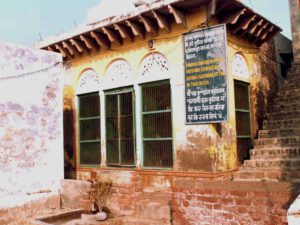
Krishnadasa Kaviraja Goswami is the author of Sri Chaitanya Charitamrita, he composed it in this place
There is some difference of opinion about Krishna Das’s caste. Once again, Srila Prabhupada, Bhaktisiddhanta Saraswati Thakur, has discussed this point: “Supporters of different ideas claim that Krishna Das was born in one of the three upper castes (Brahmin, Kayastha or Vaidya). Kaviräja is a title given to those who have proven themselves by composing literary works that have achieved renown for their quality in learned circles. Since this title is also given to Ayurvedic physicians, some people hold that Krishna Das was a Vaidya.
From this above discussion, we can see that Krishna Das may have been born in any of these three castes. Whatever the case, a Vaishnava is superior to a brahmana no matter in what caste he takes his birth. All scriptures state that a Vaishnava is the topmost of all human beings.
There is no unanimous opinion about Krishna Das’s marital status, either. Some say that he was a lifelong brahmachari when he went to Vrindavan, for had he left a wife and family, he would likely have mentioned it when telling of his renunciation. Srila Prabhupada writes in this connection, “After arriving in Vrindavan, Krishna Das became totally absorbed in Harikatha and indifferent to talk of his previous family life. He was known as Kaviraj Goswami to his spiritual family. His spiritual identity in Vraja lila is Ratnarekha Manjari, or Kasturi Manjari according to others.”
During his glorification of Nityananda Prabhu in the Chaitanya Charitamrita, Krishna Das Kaviraja describes a significant event in his life. He had organized a 24-hour kirtan at his house and amongst those invited was Lord Nityananda’s dear associate, Minaketan Rama Das, who also lived in Jhamatpur.
Minaketan was a great Vaishnava who was constantly in a state of devotional trance when he chanted the name of Nityananda Prabhu. While in ecstasy he would often slap people and sometimes tap them with his flute. In general, his ecstatic behavior was the cause of astonishment amongst Krishna Das Kaviraja’s guests and all came to pay their obeisances and offer him respect. Only Minaketan Misra’s brother who was the pujari of the festival, Gunarnava Mishra did not show proper respect to him which indicated that he had no faith in Nityananda Prabhu. Seeing this Minaketam became very angry and criticized his brother, saying: “Just look! This is a second Romaharshan Suta, who did not come forward to show respect when he saw Balaram!” (Chaitanya Charitamrita 1.5.170)
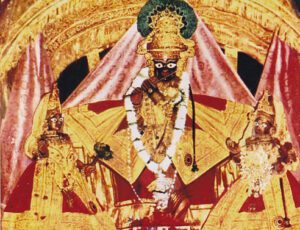
Sri Sri Radha Madan Mohan jiu served by Krishnadasa Kaviraja Goswami is the author of Sri Chaitanya Charitamrita.
The Lord is influenced by his devotees and he gives great importance to even the slightest display of attachment, bestowing upon them all that they desire. Krishna Das Kaviraj writes that by taking the side of Nityananda Prabhu’s associate and chastising his brother, he received the blessings of Nityananda Prabhu himself. Nitai came to him in a dream and ordered him to go to Vrindavan.
“O, Krishna Das! Have no fear. Go to Vrindavan, for there you will attain all things.”
After saying this, he indicated the way to Vrindavan by waving his hand & then disappeared with his associates.
(Chaitanya Charitamrita 1.5.195-6)
In contrast, a person who shows all the customary virtues, yet holds devotees in contempt, is eternally deprived of the Lord’s blessings. A good example of this is the zamindar Ramachandra Khan, who committed offenses to Hari Das Thakur as a result of which he incurred Nityananda Prabhu’s displeasure.
With words of profound humility, Krishnadasa Kaviraja Goswami proclaims the glories of Nityananda Prabhu:
I am more sinful than Jagai and Madhai and lower than a maggot in the stool. Whoever hears my name loses the results of his virtuous deeds, and whoever utters my name commits a sin. Other than Nityananda, could anyone in this world show mercy to one as abominable as me? Nityananda is the incarnation of mercy; he is so fully intoxicated by the ecstatic love that he does not discriminate between the good and the bad. He delivers anyone who falls down before him. Therefore he has delivered such a sinful and fallen person as me. (Chaitanya Charitamrita 1.5.205-9)
Without the mercy of Vishnu and the Vaishnavas, it is impossible to describe their glories. It is for this reason that Srila Krishnadasa Kaviraja Goswami begins each chapter of the Chaitanya Charitamrita with invocations to Mahaprabhu and His associates like Nityananda Prabhu, Advaita Acharya, and concludes each chapter with a prayer for service to the feet of Rupa and Raghunath Goswamis. He has thus shown how important it is to avoid any disrespect or offense to the Vaishnavas.
Vrindavan Das is the original biographer of Sri Chaitanya Mahaprabhu and is equal to Srila Vyasadeva. The way he has described Lord Chaitanya’s pastimes is very charming and delightful. Afraid that it would become too voluminous, Vrindavan Das left some pastimes out of his book. I shall try as far as possible to fill in these gaps. (Chaitanya Charitamrita 1.13.48-9)
My beloved spiritual master, HDG Bhakti Promode Puri Goswami Thakur, once explains the above statements in his foreword to the Sri Chaitanya Gaudiya Math edition of the Chaitanya Charitamrita:
“Vrindavan Das Thakur wrote an elaborate outline of Chaitanya Mahaprabhu’s Lila at the beginning of the Chaitanya Bhagavata, but as he became absorbed in describing Nityananda Prabhu’s activities, many pastimes mentioned in the outline were left out of the final version of the book.
Mahaprabhu’s devotees in Vrindavan were afraid that these pastimes would be forgotten and lost forever, so they approached Krishna Das Kaviraj, requesting him to write a complete version of these events. Krishna Das then went to the deity of Madan Mohan and asked for permission to fulfill their desire. In front of all the prominent contemporary members of the Gaudiya community in Vrindavan, Madan Mohan’s garland fell from his neck.
This was taken by all present as a sign of the Lord’s approval and they let out a joyous cheer. Madana Mohan’s pujari picked up the garland and placed it around Krishna Das’s neck. Accepting it as a sign of the Deity’s desire, Krishna Das Kaviraja began to write the 24,000 slokas of Chaitanya Charaitamrita with great humility,
“Chaitanya Charitamrita is being dictated to me by Madan Mohan. My writing is like the repetition of a parrot. I write as Madana Gopal orders me,just as a wooden marionette is made to dance by a puppeteer.”
(Chaitanya Charitamrita 1.8.78-9)
Continue reading this article here.




